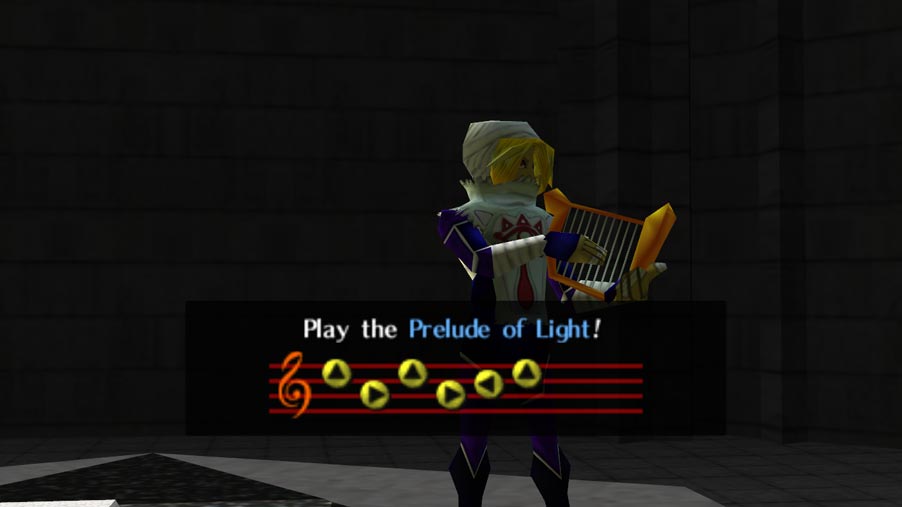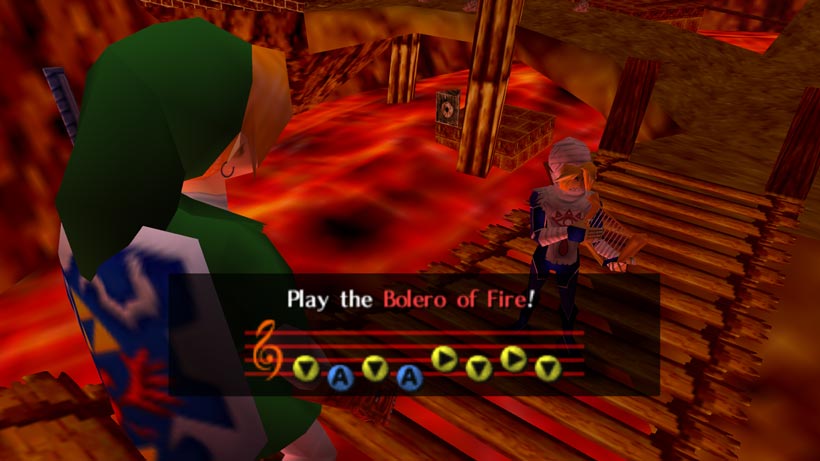This is Part Three in our music lessons from Ocarina of Time. Check out Part One here and Part Two here!
Previously we explored what The Legend of Zelda: Ocarina of Time could teach us about modes and chromatic harmony. But there is another important area of music that we didn’t touch upon that is also greatly exploited in the game: Musical form.
What is musical form? Sometimes the term is used more specifically to describe the structure of the music, e.g A section – B section – A section again (this is called Ternary form, or Rounded Binary). But it is also used to describe the style of the music. For example a piece may be a Waltz, or a March, or a Dirge etc.
When I was younger, I didn’t know the word ‘form’, I just knew there were different types of song (largely from playing Ocarina of Time, not your traditional classical education I suppose). In an effort to learn them all, I read through a musical dictionary looking for names of different forms and compiled them all in to a list I called ‘Different types of music’. How I didn’t stumble across the word ‘form’ I’ll never know. Anyway, I know it now, and so do you if you didn’t know it before.

We’ve seen how Koji Kondo used different modes to create musical variety among the 12 pieces you have to learn in Ocarina of Time, moving through Ionian, Dorian, Lydian, Aeolian etc, as well as using chromatic harmony. The variety is further increased through the use of different forms.
Of the 12 songs, the 5 we will be looking at are: Prelude of light, Minuet of Forest, Bolero of Fire, Nocturne of Shadow and Requiem of Spirit. Let’s find out what these terms mean.
Prelude
Quite commonly, the form of the piece will give you an expectation of some specific things about its contents. For example, if something is a Waltz, you know it is going to be in 3/4 time with an oom-pah-pah rhythm. If it’s a Bourrée, it will be in 2/4 or 4/4 with an anacrusis (also called an ‘upbeat’, when the melody line starts on the beat before the bar, like Bach’s famous Bourrée in E minor, or Mozart’s Turkish March). But a prelude can be almost anything stylistically. The term has no constriction on rhythm, tempo, structure or tonality.
Generally a Prelude is an instrumental piece written to precede another piece (hence the name), just like Bach’s 48 Preludes and Fugues, where the prelude leads in to the fugue (yes I use Bach in a lot of examples, you learn that about me). Often the prelude will have melodic material that is used and developed in the following pieces, like an overture to an opera, but not always. In the Baroque and Classical era it was more strictly used to describe a work preceding something else, but in the Romantic era the term became a bit more loose, and preludes are often found as short, stand-alone pieces. Chopin and Rachmaninov composed many stand-alone preludes that didn’t act as a prelude to another piece. It seems Kondo was using it in the more Romantic sense.
Minuet
Now this does definitely say something specific about the piece; its rhythm. The first thing the form of a piece tells you is normally the rhythm (but not always). Minuets are a stately ballroom dance of French origin in 3/4 time, popular in the 17th and 18th centuries. The word minuet can refer to either the dance or the music accompanying the dance.
Minuets are often written on their own or as part of a suite, not always intended for a dance. An interesting variety of them appears in Bach’s ‘Notebook for Anna Magdalena’. (Yeah I know, another Bach reference…) There’s apparently some controversy over whether he composed these specific works or not, but that’s a subject for another day.
It was quite standard in the classical era of Haydn and Mozart to have a minuet as the third movement to sonata, string quartet or symphony, often in A – A – B – A form. They can be minor key, but normally the music is generally quite light and happy and major key, befitting of a courtroom dance, so the Minuet of Forest is appropriately named. Its rhythm means it could also have been called a Slow Waltz (as opposed to a fast Viennese Waltz), but Minuet of Forest flows a little better off the tongue than ‘Slow Waltz of Forest’, don’t you think?
Bolero
Like the minuet, this is a dance with a specific rhythm, and the word can apply to either the dance or the music. Also like the minuet, it is a dance in triple time, either 3/4 or 3/2, but often slower than a minuet. It has its origins in Spain in the 18th century, but there is also a Cuban bolero from the 19th century that has different origins and is in duple time, 2/4.

With its 3/2 rhythm, the Bolero of Fire is definitely of the Spanish style. Even before I learnt what a Bolero was, this music always put me in mind of a latin ballroom dance. The solo snare drum line is very reminiscent of the famous bolero by Maurice Ravel, and has that distinctive triplet on the second half of the first beat, as is usually found in boleros.
Nocturne
This term is similar to prelude, in that it doesn’t say anything hugely specific about the piece, and again has no constriction on rhythm, tempo, structure or tonality. A nocturne is usually a short, lyrical, single-movement instrumental piece, typically for piano (but by no means exclusively), and as may be obvious from the name, is a composition generally evocative of the night (as in the word ‘nocturnal’).
The name might make you think that the music would be dark and moody, but they are often very light and happy, intended for performance at an evening soirée, or other aristocratic shindig. They began in the 18th century and were continually developed through the 19th century. Probably the most famous exponent of this style is Chopin (I know what you’re thinking, “No Bach reference?!”, well I would have, but he didn’t compose any).
The Nocturne of Shadow, with its dark and unsettling harmony, is stylistically very different from the nocturnes of Chopin, and probably wrongly convinced a young generation of gamers that a nocturne was a creepy piece of music.
Requiem
Requiem has a very specific meaning, but is often used in a looser, more colloquial sense too.
The Latin Mass for the Dead is often called the Requiem Mass, as the first word of the text is the word requiem, which is Latin for ‘rest’, as in ‘Requiem Aeterna’ – ‘Eternal rest’. So in the stricter sense, if someone is composing a Requiem Mass it means they are writing original, multi-movement liturgical music to the Latin Mass for the Dead. By the way, if you’re looking for a good example of a Requiem you can’t go wrong with Mozart’s, it’s a masterpiece.
In a looser sense, a Requiem can be a piece of music written in remembrance of someone or something, like an elegy, and is therefore a solemn, sad piece of music. Requiem of Spirit is obviously using Requiem in this looser fashion. (I don’t think the people of Hyrule use the Latin Mass for the Dead…)
Composing Tip: If you want to write some music but your creative juices have dried up and you don’t know where to begin, try choosing a form first. For example, if you decide that you are going to compose a Bolero, immediately you know what rhythm and style of music you are going for, and it’s easier to get started. Limiting yourself is a great way of increasing creativity and productivity. Give it a try!
If you enjoyed this lesson, make sure you check out our other blogs, and stay tuned for further lessons. If you’re serious about furthering your knowledge and your career in music, check out our Postgraduate and Premium courses on our website and see which ones are suitable for you. We’re always happy to help, so send us an email at contact@thinkspace.ac.uk with any questions and we’ll get back to you.

